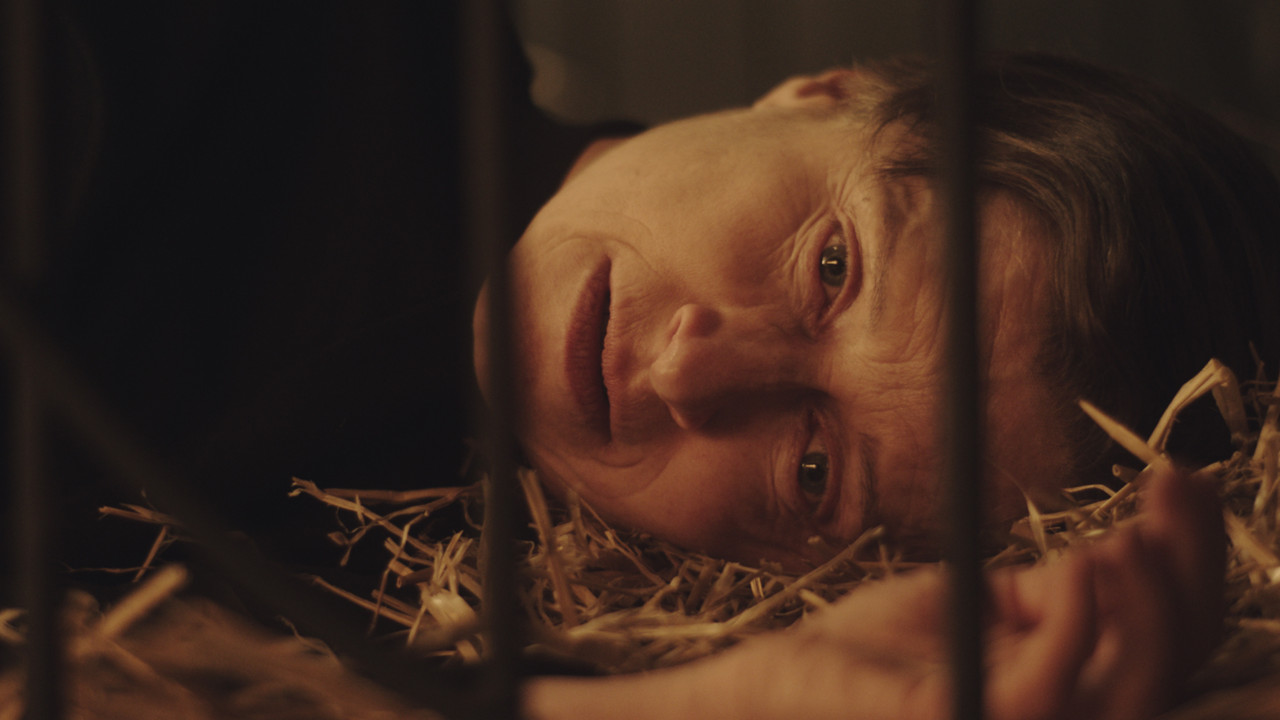


Daria Martin: A Hunger Artist at Maureen Paley, London
The striking central image of Daria Martin’s latest film is that of the mute and emaciated artist in a cage. Based closely on Franz Kafka’s 1922 short story of the same name, Martin’s film enables all of the many questions that arise from Kafka’s subtle and teasing parable, as well as connecting with concerns that have preoccupied her throughout her career. The parable poses acute questions around the artist’s relationship to his own art, to his audience and to the commercial world.
Throughout the 19th century, in Europe as well as America, there was a fashion for the spectacle of hunger artists as a popular entertainment. A number of individuals became internationally renowned for their feats of self-denial and David Blaine’s 2003 stunt in London closely resembled his historic forebears, not least in provoking taunting and general scepticism about the authenticity of the fast. In Kafka’s story the services of three stout butchers were enlisted to watch the hunger artist and attest to his not having eaten.
In the early years of the 20th century the fashion suddenly passed and hunger artists no longer attracted the crowds, or their money. By 1922 Kafka could create a protagonist looking back to the glory days of his ascetic career, aware that, while the degree of his ambition was misunderstood even then, at the end of it no one cared at all.
In the opening scenes, with full theatrical pomp, the hunger artist’s impresario rouses the crowd with hyperbolic flummery. Martin’s first HD film lingers in gold-suffused colours on the avid faces the well-fed audience, focusing on the wet mouths, the nursing mother, the wine glasses on the tables of the café-theatre. In stark contrast, on the stage the hunger artist lies on straw in his cage, his eyes calm but staring, his face prematurely lined by self-induced suffering. The contract between artist and audience is founded on one side by a macabre fascination with emaciation and the ability to master fundamental human instinct, and on the other by a fetishistic attachment to self-denial.
More than illustrating a simple mind/body opposition, there is the suggestion, in the impresario’s patter, that the act of starving oneself has a spiritual or supernatural dimension. At one point the hunger artist beckons a small girl from the audience; she mounts the stage and the artist extends an emaciated hand through the bars for her to touch. Like an act of homage to a holy martyr, the interaction between the artist and the girl encourages the idea that there is inherent virtue in his act of endurance. After the artist is released from his cage at the end of his forty-day ordeal and the audience has left, the impresario counts the takings. The artist wearily waves away the handful of coins, indicating his more comprehensive denial of reality of the world he lives in. His art, it seems, amply justifies itself, without need of remuneration.
For fifteen years, Daria Martin’s work has concerned itself with the relationships between performers and their audiences. She has explored early 20th century fascinations with the relationship between man and machine, and worked with AI scientists in 2004 to make Soft Materials, in which robots were programmed to learn through the experience of their own bodies, rather than a more cerebral, external programming. More recently Martin has explored the phenomenon of mirror-touch synaesthesia – the ability of some individuals to feel the physical sensations experienced by others. This question of the possibility of human empathy is also key to A Hunger Artist.
The body of the artist is experienced by the audience, and by the artist himself as object as well as subject – as an object of display and measurement, as a site of suffering, as a visual index of endurance as day by day the length of the feat of fasting becomes more extreme. The artist’s only attribute in his cage is the large clock that counts down the minutes, hours and days. The awe he inspires in the audience is more akin to fascinated revulsion than sympathy – encouraged by the impresario who refers to the artist as ‘super-human’. When public appetite for spectacle inevitably moves on and touring their act is no longer financially viable, the impresario leaves and the wilfully unworldly hunger artist is left to negotiate with the venal circus proprietor.
His lack of commercial currency sees him excluded from the Big Top and relegated to a spot near to the menagerie. There he begins his last fast, unconstrained by the impresario who insisted that there was no public demand for a fast beyond the biblical 40 days and 40 nights. Entirely forgotten in his cage, the days of his fast no longer counted by anyone, the hunger artist’s last, and only words in the film are “I always wanted you to admire my fasting”. He follows this with the revelation that, in his view, there is nothing to admire in it since he could do nothing else: he had never found any food that he liked. What sustained him, finally, was that his feats of abstinence were acknowledged.
Having witnessed these last words, the circus proprietor briskly orders the cage cleared – and in place of the artist installs a magnificent black panther. Gleaming, muscular, uncomplicatedly voracious, the animal attracts a huge crowd, fixated almost pornographically on the animal’s snarling maw and fleshy, saliva-slicked tongue.
A Hunger Artist was co-commissioned by Site Gallery in Sheffield; Schering Stiftung, Berlin; and Visual, Carlow, Ireland. This is the first chance to see it in London and I highly recommend it.
Caroline Douglas
Director
Maureen Paley, 21 Herald St, London E2 6JT. Open Monday - Friday, 10.00 - 18.00. Exhibition opens tomorrow (PV 18.00-20.00) and continues until 23 September 2018. www.maureenpaley.com